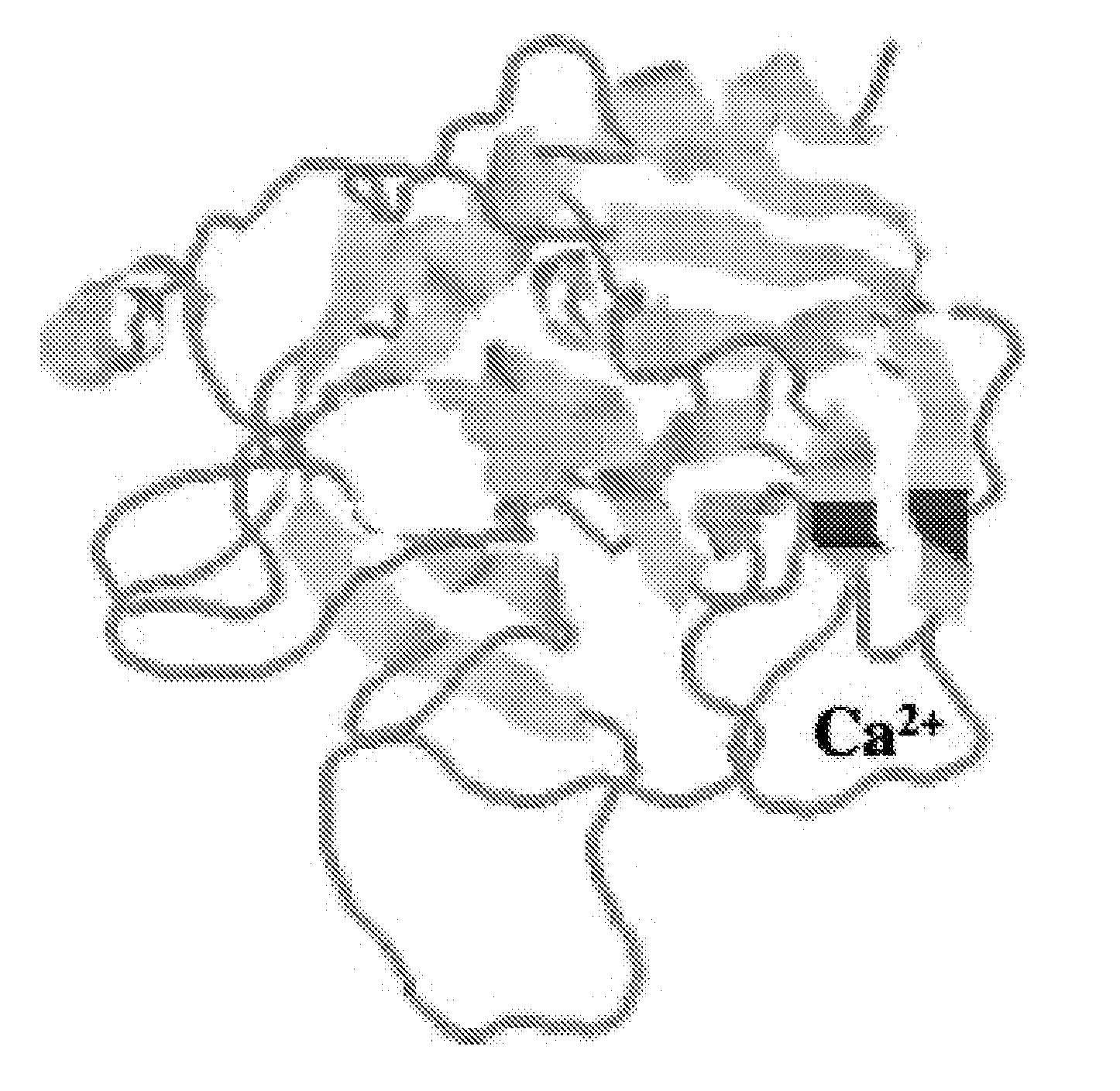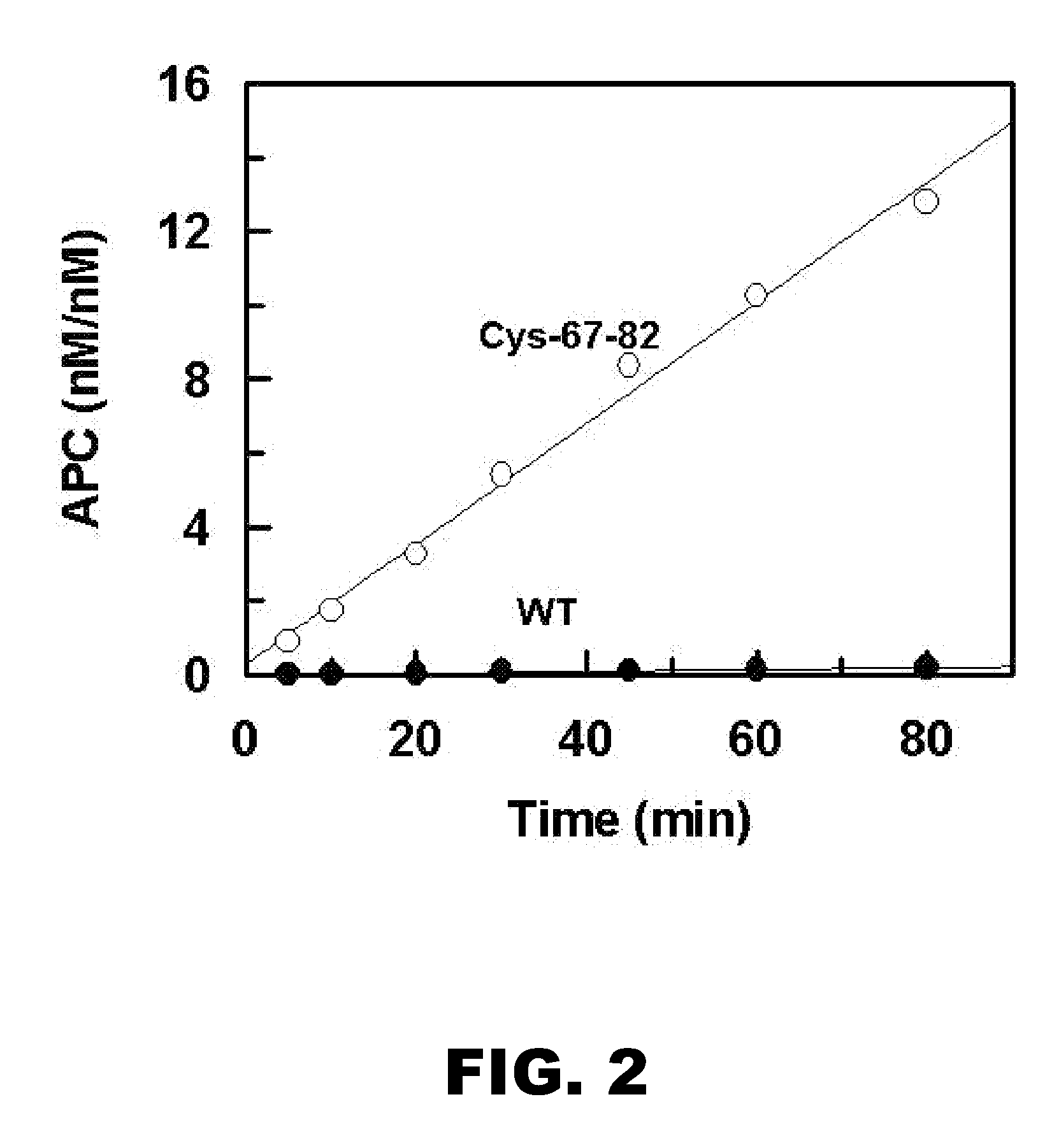Methods and compositions for activated protein c with reduced Anti-coagulant properties
a technology of activated protein and anti-coagulant properties, which is applied in the field of therapeutic use of protein c, can solve the problems of not being solved, the risk of bleeding prevents medical practitioners from fully utilizing apc therapy, and the increase in the incidence of bleeding remains a major drawback, so as to achieve the effect of easy activation and without the increase in the risk of bleeding
- Summary
- Abstract
- Description
- Claims
- Application Information
AI Technical Summary
Benefits of technology
Problems solved by technology
Method used
Image
Examples
example 1
Protein C Activation by Thrombin
[0093] Protein C exists in the form of a zymogen and requires activation to exert its cytoprotective and anti-coagulant properties. Thrombin is a very poor activator of protein C in the absence of thrombomodulin (TM) (Esmon CT. (1993) Thromb. Haemost. 70:1-5). Activation of wild-type and cross-linked protein C (Cys-67-82) was compared to determine if the rate activation by free thrombin was increased.
[0094] The initial rate of protein C activation by thrombin was measured in 0.1 M NaCl, 0.02 M Tris-HCl, pH 7.4 (TBS) containing 1 mg / mL bovine serum albumin (BSA), 0.1% polyethylene glycol (PEG) 8000 and 2.5 mM Ca2+ (TBS / Ca2+) in 96-well assay plates as described (Yang et al. (2006) Proc Natl Acad Sci. (USA); 103:879-884) and herein incorporated by reference. At different time intervals, thrombin activity was quenched by 500 nM AT in complex with 1 μM heparin. The activation rate was measured by an amidolytic activity assay using Spectrozyme PCa, and a...
example 2
Anti-Coagulant Activity
[0098] The anti-coagulant activity of wild-type and Cys-67-82 APC was examined in purified and plasma-based clotting assays. In the purified system, APC concentration dependence of fVa inactivation was measured by a prothrombinase assay from a decrease in the fVa-catalyzed prothrombin activation as described (Yang et al. (2005) Thromb Haemostas.; 94:60-68). Essentially, fVa (5 nM) was incubated with wild-type or mutant APC (1 nM) on 25 μM PC / PS vesicles in TBS containing 2.5 mM Ca2+, 0.5 mg / ml BSA and 0.1% PEG 8000. In the second stage, at different time intervals (0-40 min), the remaining fVa activity was determined in a prothrombinase assay from the fVa-catalyzed prothrombin activation by fXa. The prothrombinase assay was carried out for 30 sec with excess prothrombin (1 μM) and a saturating fXa (10 nM) at room temperature. The remaining activity of fVa was determined from the decreased rate of thrombin generation as monitored by an amidolytic activity assa...
example 3
Effect of APC on Thrombin-Induced Permeability
[0101] It is known that thrombin disrupts the permeability barrier of endothelial cells, thereby further propagating the inflammatory response. It is also known that APC provides potent protection against these effects (Feistritzer et al. (2005) Blood.; 105:3178-3184). To determine whether Cys-67-82 APC retained this protective property, an assay was designed to compare the protective effect of Cys-67-82 APC with that of the wild-type APC.
[0102] Permeability was quantitated by spectrophotometric measurement of the flux of Evans blue-bound albumin across functional EA.hy926 cell monolayers using a modified 2-compartment chamber model as previously described (Feistritzer et al. (2005) Blood.; 105:3178-3184). Briefly, EA.hy926 cells were plated (5×104 / well) in transwell of 3 μm pore size and 12-mm diameter for 4-6 days. The confluent monolayers were incubated with APC (20 nM) for 3 h followed by activation by thrombin (5 nM) for 10 min as...
PUM
| Property | Measurement | Unit |
|---|---|---|
| time | aaaaa | aaaaa |
| temperature | aaaaa | aaaaa |
| temperature | aaaaa | aaaaa |
Abstract
Description
Claims
Application Information
 Login to View More
Login to View More - R&D
- Intellectual Property
- Life Sciences
- Materials
- Tech Scout
- Unparalleled Data Quality
- Higher Quality Content
- 60% Fewer Hallucinations
Browse by: Latest US Patents, China's latest patents, Technical Efficacy Thesaurus, Application Domain, Technology Topic, Popular Technical Reports.
© 2025 PatSnap. All rights reserved.Legal|Privacy policy|Modern Slavery Act Transparency Statement|Sitemap|About US| Contact US: help@patsnap.com



